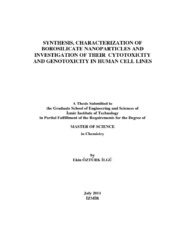Please use this identifier to cite or link to this item:
https://hdl.handle.net/11147/3105Full metadata record
| DC Field | Value | Language |
|---|---|---|
| dc.contributor.advisor | Özçelik, Serdar | en |
| dc.contributor.author | Öztürk İlgü, Ekin | - |
| dc.date.accessioned | 2014-07-22T13:50:52Z | - |
| dc.date.available | 2014-07-22T13:50:52Z | - |
| dc.date.issued | 2011 | en |
| dc.identifier.uri | http://hdl.handle.net/11147/3105 | - |
| dc.description | Thesis (Master)--İzmir Institute of Technology, Chemistry, İzmir, 2011 | en |
| dc.description | Includes bibliographical references (leaves: 49-52) | en |
| dc.description | Text in English; Abstract: Turkish and English | en |
| dc.description | xi, 52 leaves | en |
| dc.description.abstract | In this study, firstly, we aimed to synthesize silica and borosilicate nanoparticles by the Stöber method. We then investigated the biological response of bronchoalveolar carcinoma-derived cells (A549) and healthy bronchoalveolar cells (BEAS2B) against the silica and borosilicate nanoparticles, by evaluating cytotoxicity and genotoxicity. The nanoparticles were synthesized by a modified Stöber method. To prepare borosilicate nanoparticles tri methoxy boroxine (TMB) was used as boron source to coat the surface of the silica nanoparticles. By varying the amounts of ethanol and ammonia the size of nanoparticles were tuned from 60 to 450 nm. We proved the presence of boron in the borosilicate nanoparticles by Energy-Dispersive X-ray (EDX), Fourier Transformed Infrared (FTIR) spectroscopy and an acid-base titration method. Cytotoxicity and genotoxicity induced both silica and borosilicate nanoparticles were investigated for the cell lines of A549 and BEAS-2B. Silica and borosilicate nanoparticles in all three sizes and dosages up to 500 μg/mL did not induce cytotoxic effects in A549 cells with incubation time up to 72 hours. The same amount of particles did not result in any cytotoxicity in BEAS-2B cells for 24 hours incubation, but they showed cytotoxic effects when the incubation time was increased to 48 and 72 hours. Furthermore, nanoparticles with sizes of 60 and 100 nm showed no genotoxicity for A549 but for BEAS-2B cells, silica nanoparticles induced genotoxic effects contrary to borosilicate nanoparticles. | en |
| dc.language.iso | en | en_US |
| dc.publisher | Izmir Institute of Technology | en_US |
| dc.rights | info:eu-repo/semantics/openAccess | en_US |
| dc.subject.lcsh | Boron--Analysis | en |
| dc.subject.lcsh | Silicates--Analysis | en |
| dc.subject.lcsh | Borates | en |
| dc.subject.lcsh | Nanoparticles | en |
| dc.subject.lcsh | Genetic toxicology | en |
| dc.subject.lcsh | Cell-mediated cytotoxicity | en |
| dc.title | Snythesis, characterization of borosilicate nanoparticles and investigation of their cytotoxicity and genotoxicity in human cell lines | en_US |
| dc.type | Master Thesis | en_US |
| dc.institutionauthor | Öztürk İlgü, Ekin | - |
| dc.department | Thesis (Master)--İzmir Institute of Technology, Chemistry | en_US |
| dc.relation.publicationcategory | Tez | en_US |
| item.languageiso639-1 | en | - |
| item.fulltext | With Fulltext | - |
| item.openairecristype | http://purl.org/coar/resource_type/c_18cf | - |
| item.openairetype | Master Thesis | - |
| item.grantfulltext | open | - |
| item.cerifentitytype | Publications | - |
| Appears in Collections: | Master Degree / Yüksek Lisans Tezleri | |
Files in This Item:
| File | Description | Size | Format | |
|---|---|---|---|---|
| T000919.pdf | MasterThesis | 3.86 MB | Adobe PDF |  View/Open |
CORE Recommender
Page view(s)
130
checked on Jul 22, 2024
Download(s)
134
checked on Jul 22, 2024
Google ScholarTM
Check
Items in GCRIS Repository are protected by copyright, with all rights reserved, unless otherwise indicated.